Tarek Ahmed. Reservoir engineering handbook
Подождите немного. Документ загружается.

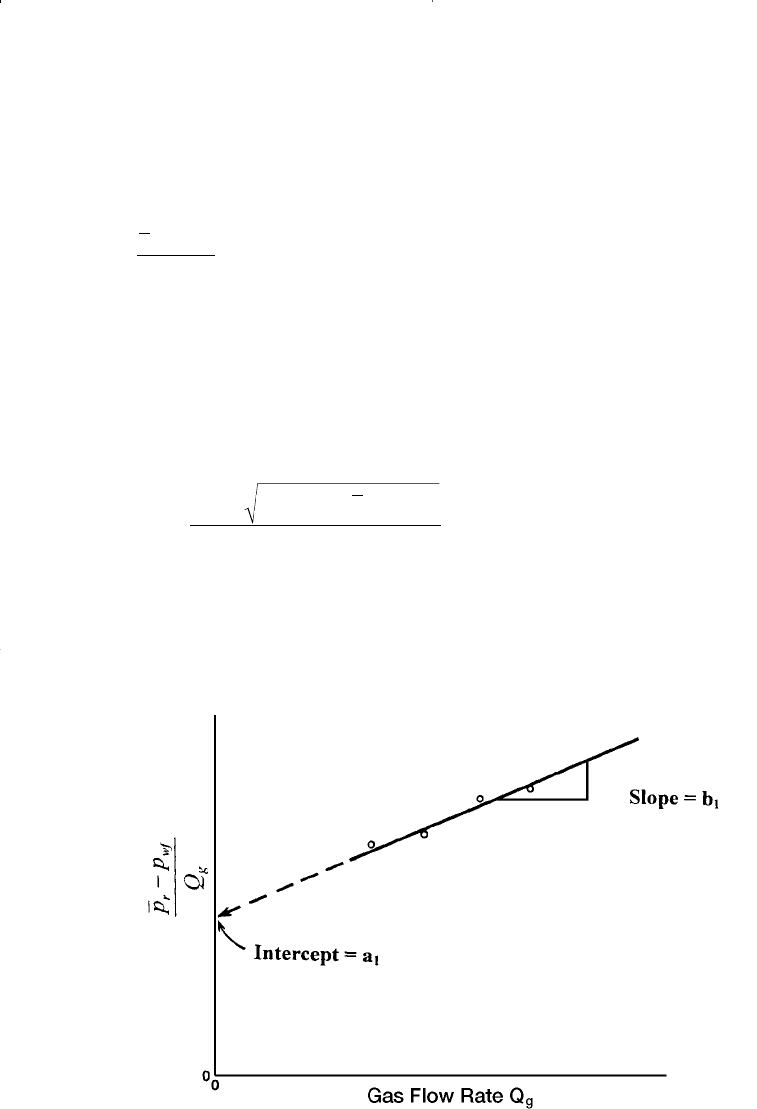
the turbulent flow condition. In a linear form, Equation 8-17 can be
expressed as:
The laminar flow coefficient a
1
and inertial-turbulent flow coefficient
b
1
can be determined from the linear plot of the above equation as shown
in Figure 8-5.
Having determined the coefficient a
1
and b
1
, the gas flow rate can be
determined at any pressure from:
The application of Equation 8-29 is also restricted by the assumptions
listed for the pressure-squared approach. However, the pressure method
is applicable at pressures higher than 3000 psi.
Q
aa bpp
b
g
rwf
=
-+ + -
(
)
11
2
1
1
4
2
(8 - 33)
pp
Q
abQ
rwf
g
g
-
=+
11
(8 - 32)
548 Reservoir Engineering Handbook
Figure 8-5. Graph of the pressure-method data.
Reservoir Eng Hndbk Ch 08 2001-10-24 11:13 Page 548

c. Pseudopressure Quadratic Approach
Equation 8-19 can be written as:
where
The term (a
2
Q
g
) in Equation 8-34 represents the pseudopressure
drop due to laminar flow while the term (b
2
Q
g
2
) accounts for the
pseudopressure drop due to inertial-turbulent flow effects.
Equation 8-34 can be linearized by dividing both sides of the equa-
tion by Q
g
to yield:
The above expression suggests that a plot of versus Q
g
on a Cartesian scale should yield a straight line with a slope of b
2
and
intercept of a
2
as shown in Figure 8-6.
Given the values of a
2
and b
2
, the gas flow rate at any p
wf
is calcu-
lated from:
It should be pointed out that the pseudopressure approach is more rig-
orous than either the pressure-squared or pressure-approximation method
and is applicable to all ranges of pressure.
Q
aab
b
g
rwf
=
-+ + -
22
2
2
2
4
2
()yy
(8 - 38)
yy
rwf
g
Q
-
Ê
Ë
Á
ˆ
¯
˜
yy
rwf
g
g
Q
abQ
-
+
22
(8 - 37)
b
kh
D
2
1422
=
Ê
Ë
ˆ
¯
(8 - 36)
a
kh
r
r
s
e
w
2
1422
075=
Ê
Ë
ˆ
¯
Ê
Ë
Á
ˆ
¯
˜
-+
È
Î
Í
Í
˘
˚
˙
˙
ln . (8 - 35)
yy
rwf g
g
aQ bQ-= +
22
2
(8 - 34)
Gas Well Performance 549
Reservoir Eng Hndbk Ch 08 2001-10-24 11:13 Page 549
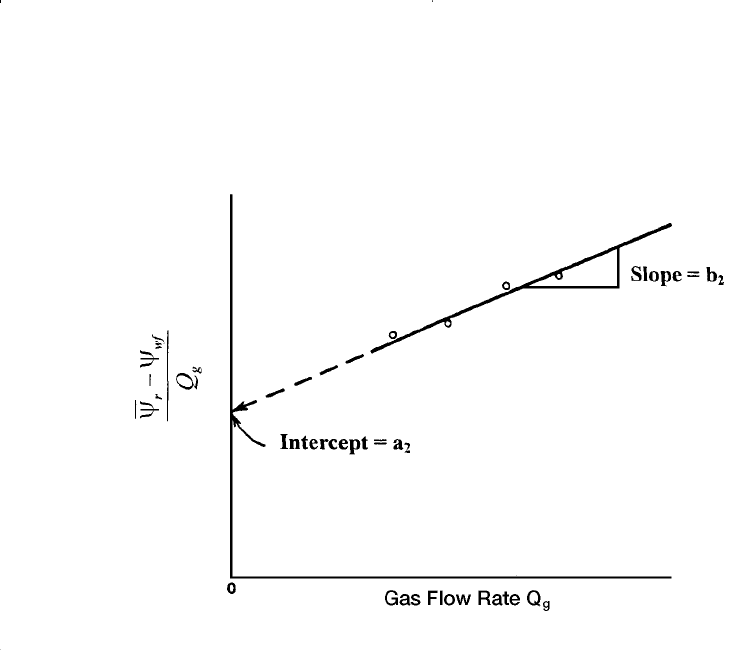
In the next section, the back-pressure test is introduced. The material,
however, is intended only to be an introduction. There are several excel-
lent books by the following authors that address transient flow and well
testing in great detail:
• Earlougher (1977)
• Matthews and Russell (1967)
• Lee (1982)
• Canadian Energy Resources Conservation Board (1975).
The Back-Pressure Test
Rawlins and Schellhardt (1936) proposed a method for testing gas
wells by gauging the ability of the well to flow against various back pres-
sures. This type of flow test is commonly referred to as the conventional
deliverability test. The required procedure for conducting this back-pres-
sure test consists of the following steps:
550 Reservoir Engineering Handbook
Figure 8-6. Graph of real gas pseudo-pressure data.
Reservoir Eng Hndbk Ch 08 2001-10-24 11:13 Page 550
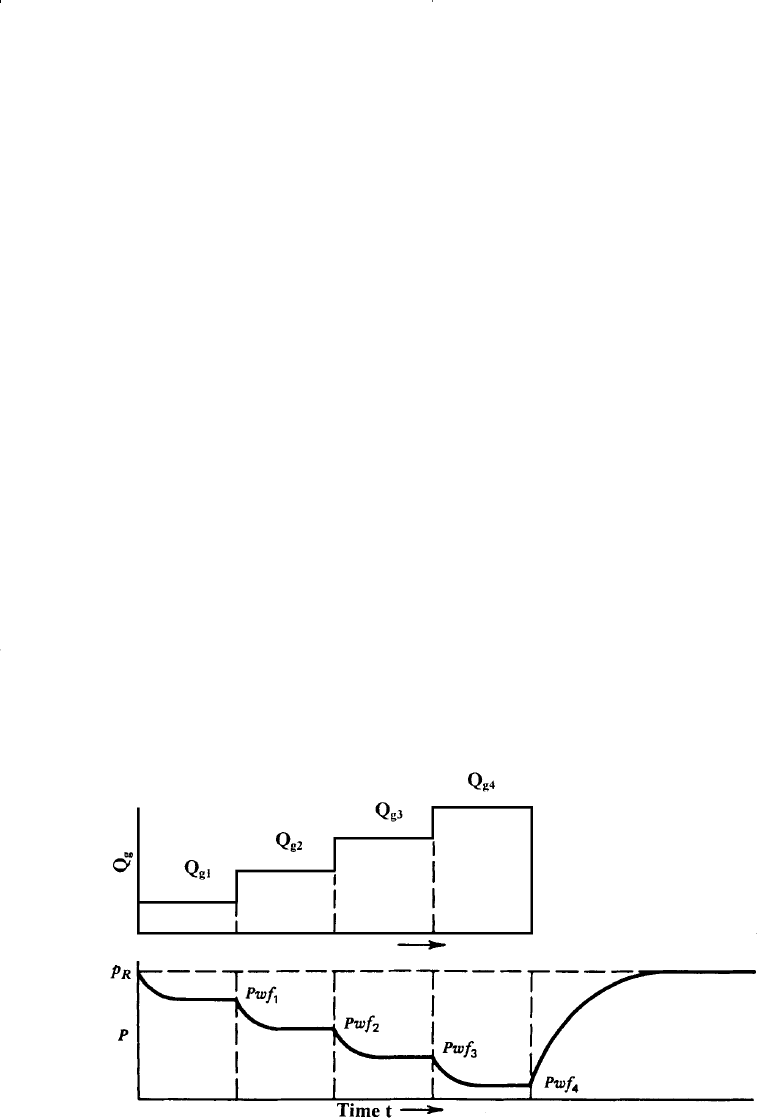
Step 1. Shut in the gas well sufficiently long for the formation pressure to
equalize at the volumetric average pressure p
–
r
.
Step 2. Place the well on production at a constant flow rate Q
g1
for a suf-
ficient time to allow the bottom-hole flowing pressure to stabilize
at p
wf1
, i.e., to reach the pseudosteady state.
Step 3. Repeat Step 2 for several rates and the stabilized bottom-hole
flow pressure is recorded at each corresponding flow rate. If three
or four rates are used, the test may be referred to as a three-point
or four-point flow test.
The rate and pressure history of a typical four-point test is shown in
Figure 8-7. The figure illustrates a normal sequence of rate changes
where the rate is increased during the test. Tests may be also run, howev-
er, using a reverse sequence. Experience indicates that a normal rate
sequence gives better data in most wells.
The most important factor to be considered in performing the conven-
tional deliverability test is the length of the flow periods. It is required
that each rate be maintained sufficiently long for the well to stabilize,
i.e., to reach the pseudosteady state. The stabilization time for a well in
the center of a circular or square drainage area may be estimated from:
Gas Well Performance 551
Figure 8-7. Conventional back-pressure test.
Reservoir Eng Hndbk Ch 08 2001-10-24 11:13 Page 551

where t
s
= stabilization time, hr
f=porosity, fraction
m
g
= gas viscosity, cp
S
g
= gas saturation, fraction
k = gas effective permeability, md
p
–
r
= average reservoir pressure, psia
r
e
= drainage radius, ft
The application of the back-pressure test data to determine the coeffi-
cients of any of the empirical flow equations is illustrated in the follow-
ing example.
Example 8-2
A gas well was tested using a three-point conventional deliverability
test. Data recorded during the test are given below:
p
wf
, psia y
wf
, psi
2
/cp Q
g
, Mscf/day
p
–
r
= 1952 316 ¥ 10
6
0
1700 245 ¥ 10
6
2624.6
1500 191 ¥ 10
6
4154.7
1300 141 ¥ 10
6
5425.1
Figure 8-8 shows the gas pseudopressure y as a function of pressure.
Generate the current IPR by using the following methods.
a. Simplified back-pressure equation
b. Laminar-inertial-turbulent (LIT) methods:
i. Pressure-squared approach, Equation 8-29
ii. Pressure-approach, Equation 8-33
iii. Pseudopressure approach, Equation 8-26
c. Compare results of the calculation.
t
Sr
kp
s
gge
r
=
1200
2
fm
(8 - 39)
552 Reservoir Engineering Handbook
Reservoir Eng Hndbk Ch 08 2001-10-24 11:13 Page 552
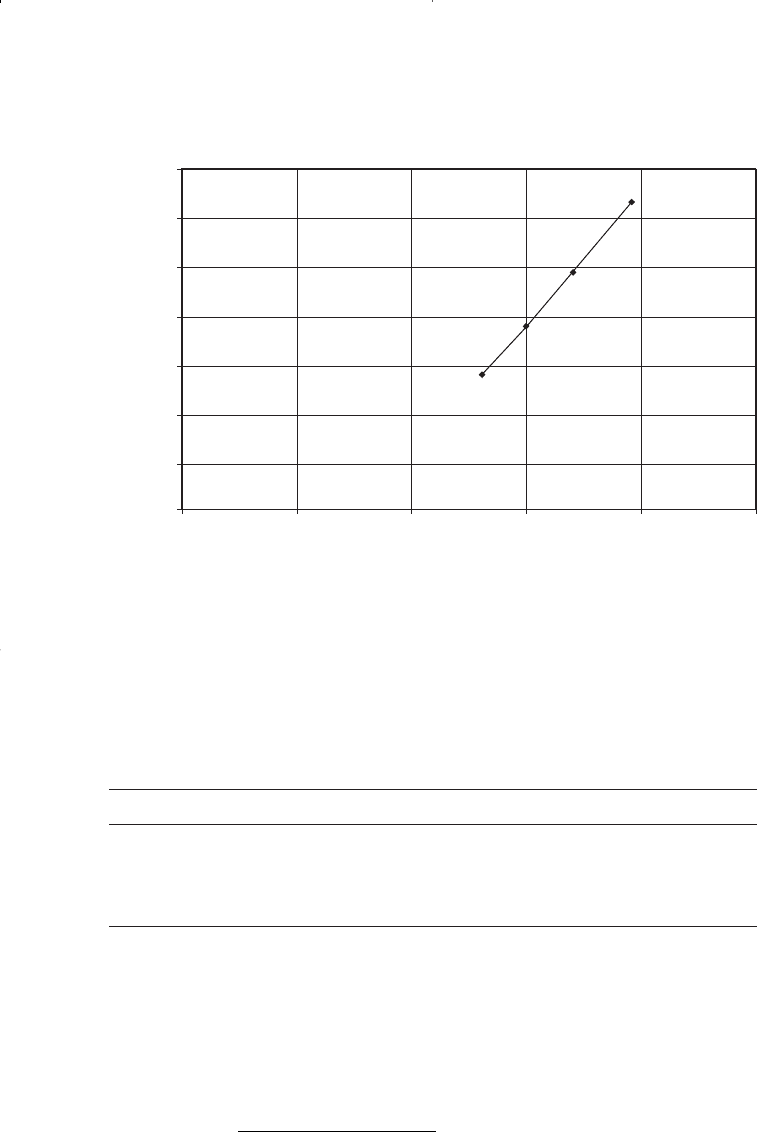
Solution
a. Back-Pressure Equation:
Step 1. Prepare the following table:
p
wf
p
2
wf
, psi
2
¥ 10
3
(p
–
r
2
- p
2
wf
), psi
2
¥ 10
3
Q
g
, Mscf/day
p
–
r
= 1952 3810 0 0
1700 2890 920 2624.6
1500 2250 1560 4154.7
1300 1690 2120 5425.1
Step 2. Plot (p
–
r
2
- p
2
wf
) versus Q
g
on a log-log scale as shown in Figure
8-9. Draw the best straight line through the points.
Step 3. Using any two points on the straight line, calculate the expo-
nent n from Equation 8-22, as
n =
-
-
=
log( ) log( )
log( ) log( )
.
4000 1800
1500 600
087
Gas Well Performance 553
5.00E+07
0.00E+00
0
1.00E+08
1.50E+08
2.00E+08
2.50E+08
3.00E+08
3.50E+08
500 1000 1500 2000 2500
Pressure
Real Gas Potential
Figure 8-8. Real gas potential vs. pressure.
Reservoir Eng Hndbk Ch 08 2001-10-24 11:13 Page 553
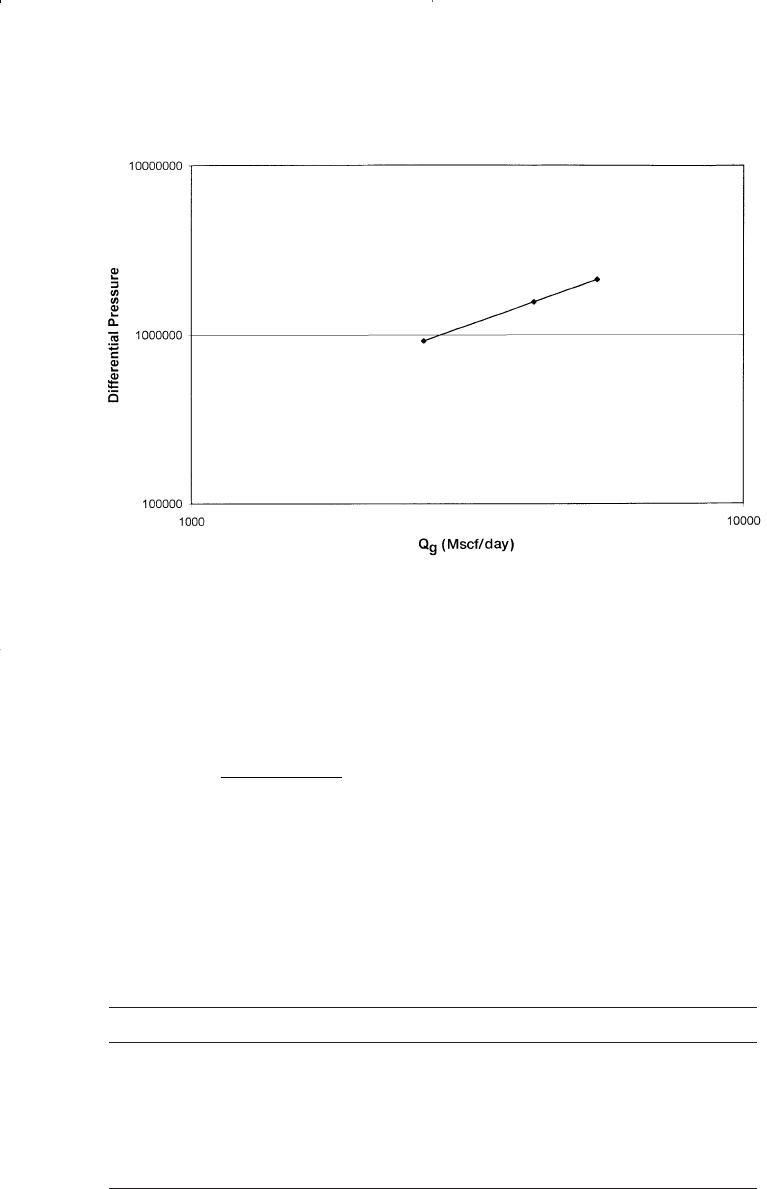
Step 4. Determine the performance coefficient C from Equation 8-23
by using the coordinate of any point on the straight line, or:
Step 5. The back-pressure equation is then expressed as:
Q
g
= 0.0169 (3,810,000 - p
2
wf
)
0.87
Step 6. Generate the IPR data by assuming various values of p
wf
and
calculate the corresponding Q
g
.
p
wf
Q
g
, Mscf/day
1952 0
1800 1720
1600 3406
1000 6891
500 8465
0 8980 = AOF = (Q
g
)
max
C Mscf psi==
1800
600 000
0 0169
087
2
(, )
./
.
554 Reservoir Engineering Handbook
Figure 8-9. Back-pressure curve.
Reservoir Eng Hndbk Ch 08 2001-10-24 11:13 Page 554

b. LIT Method
i. Pressure-squared method
Step 1. Construct the following table:
p
wf
(p
–
r
2
- p
2
wf
), psi
2
¥ 10
3
Q
g
, Mscf/day (p
–
r
2
- p
2
wf
)/Q
g
p
–
r
= 1952 0 0 —
1700 920 2624.6 351
1500 1560 4154.7 375
1300 2120 5425.1 391
Step 2. Plot (p
–
r
2
- p
2
wf
)/Q
g
versus Q
g
on a Cartesian scale and draw the
best straight line as shown in Figure 8-10.
Step 3. Determine the intercept and the slope of the straight line to give:
intercept a = 318
slope b = 0.01333
Step 4. The quadratic form of the pressure-squared approach can be
expressed as:
(3,810,000 - p
2
wf
) = 318 Q
g
+ 0.01333 Q
g
2
Gas Well Performance 555
320.00
300.00
0
340.00
360.00
380.00
400.00
1000 2000 3000 4000 60005000
Flow Rate
Differential Pressure Over Flow Rate
Figure 8-10. Pressure-squared method.
Reservoir Eng Hndbk Ch 08 2001-10-24 11:13 Page 555

Step 5. Construct the IPR data by assuming various values of p
wf
and
solving for Q
g
by using Equation 8-28.
p
wf
(p
–
r
2
- p
2
wf
), psi
2
¥ 10
3
Q
g
, Mscf/day
p
–
r
= 1952 0 0
1800 570 1675
1600 1250 3436
1000 2810 6862
500 3560 8304
0 3810 8763 = AOF = (Q
g
)
max
ii. Pressure-approximation method
Step 1. Construct the following table:
P
wf
(p
–
r
- p
wf
)Q
g
, Mscf/day (p
–
r
- p
wf
)/Q
g
p
–
r
= 1952 0 0 —
1700 252 262.6 0.090
1500 452 4154.7 0.109
1300 652 5425.1 0.120
Step 2. Plot (p
–
r
- p
wf
)/Q
g
versus Q
g
on a Cartesian scale as shown in
Figure 8-11.
Draw the best straight line and determine the intercept and
slope as:
intercept a
1
= 0.06
slope b
1
= 1.111 ¥ 10
-5
Step 3. The quadratic form of the pressure-approximation method is
then given by:
(1952 - p
wf
) = 0.06 Q
g
+ 1.111 (10
-5
) Q
2
g
Step 4. Generate the IPR data by applying Equation 8-33:
p
wf
(p
–
r
- p
wf
)Q
g
, Mscf/day
1952 0 0
1800 152 1879
1600 352 3543
1000 952 6942
500 1452 9046
0 1952 10827
556 Reservoir Engineering Handbook
Reservoir Eng Hndbk Ch 08 2001-10-24 11:13 Page 556
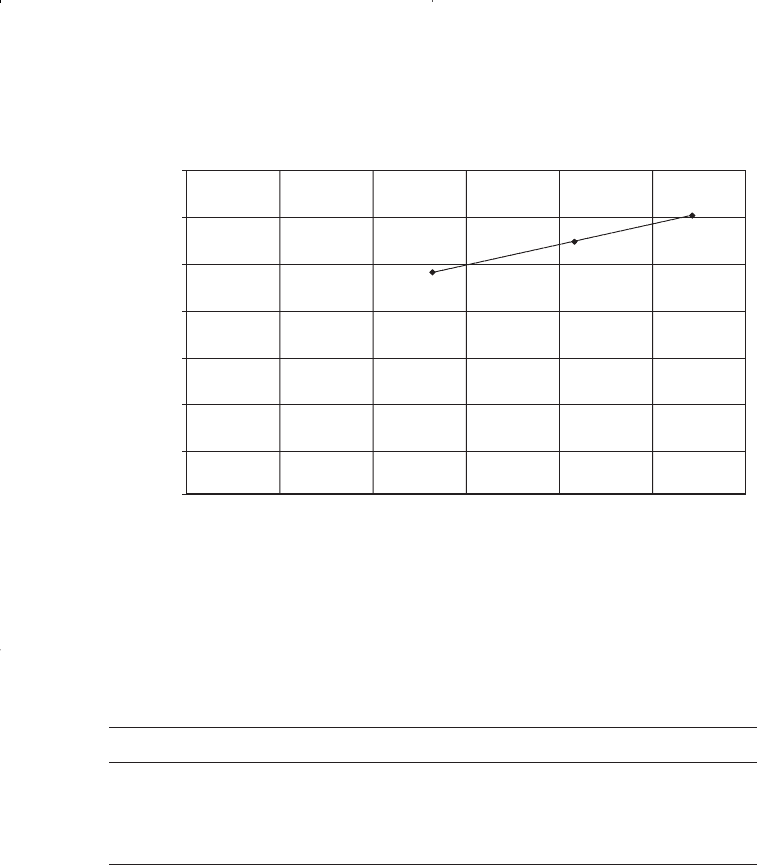
iii. Pseudopressure approach
Step 1. Construct the following table:
p
wf
y, psi
2
/cp (y
–
r
-y
wf
)Q
g
, Mscf/day (y
–
r
-y
wf
)/Q
g
p
–
r
= 1952 316 ¥ 10
6
00 —
1700 245 ¥ 10
6
71 ¥ 10
6
262.6 27.05 ¥ 10
3
1500 191 ¥ 10
6
125 ¥ 10
6
4154.7 30.09 ¥ 10
3
1300 141 ¥ 10
6
175 ¥ 10
6
5425.1 32.26 ¥ 10
3
Step 2. Plot (y
–
r
-y
wf
)/Q
g
on a Cartesian scale as shown in Figure 8-12
and determine the intercept a
2
and slope b
2
, or:
a
2
= 22.28 ¥ 10
3
b
2
= 1.727
Step 3. The quadratic form of the gas pseudopressure method is given by:
(316 ¥ 10
6
- y
wf
) = 22.28 ¥ 10
3
Q
g
+ 1.727 Q
2
g
Step 4. Generate the IPR data by assuming various values of p
wf
, i.e.,
y
wf
, and calculate the corresponding Q
g
from Equation 8-38.
Gas Well Performance 557
0.02
0.00
0
0.04
0.06
0.08
0.10
0.12
0.14
1000 2000 3000 4000 60005000
Flow Rate
Differential Pressure Over Flow Rate
Figure 8-11. Pressure-approximation method.
Reservoir Eng Hndbk Ch 08 2001-10-24 11:13 Page 557
